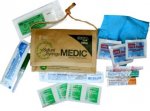FireGirl_Photo
Observer
I'm curious, what sort of training advocates suturing in the field?
Thanks for the feedback, guys. My work takes me into a host of third-world situations, including disaster response situations and medical aid - of any sort - is often more than five hours away. I'm well aware suturing in the field is not the best idea... trust me, I don't want to wield a needle if I don't have to, but wanted this skill in my repertoire in a worst-case scenario situation. Fingers crossed the equipment will go untouched!
And, as Arclight noted, in third-world situations, often clinic equipment is not the cleanest. I'd rather have a kit I know is sterile if there is stitching going on - for myself or someone else. Saw some very nasty infections recently in rural Russia from unclean equipment.

